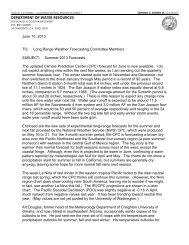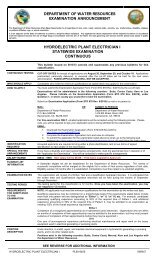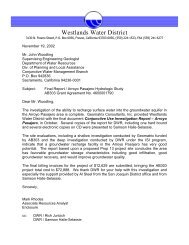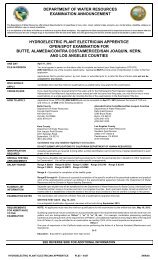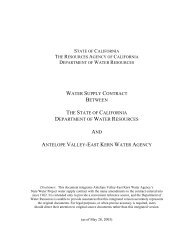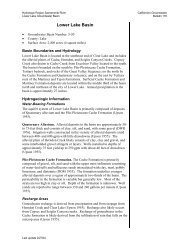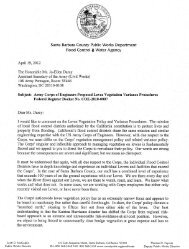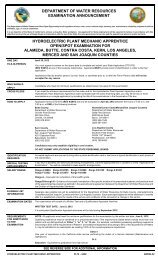Bulletin 1.pdf - California Department of Water Resources - State of ...
Bulletin 1.pdf - California Department of Water Resources - State of ...
Bulletin 1.pdf - California Department of Water Resources - State of ...
Create successful ePaper yourself
Turn your PDF publications into a flip-book with our unique Google optimized e-Paper software.
WATER RESOURCES OF CALIFORNIA 21<br />
<strong>Department</strong> <strong>of</strong> Public Works, pursuant to Divisions 1 and 2 <strong>of</strong> the <strong>State</strong><br />
<strong>Water</strong> Code (formerly the <strong>Water</strong> Commission Act). In contrast with<br />
either a riparian right to surface water or an overlying right to ground<br />
water, an appropriative right is created by use and is lost by nonuse.<br />
The opposing riparian doctrine as now established in <strong>California</strong> consists<br />
<strong>of</strong>the old common law rule, as modified by <strong>California</strong> court decisions,<br />
and particularly by Section 3 <strong>of</strong> Article XIV <strong>of</strong> the <strong>State</strong> Constitution<br />
adopted in 1928, and decisions following and applying it. rnder this<br />
doctrine, a riparian landowner is entitled to a reasonable use <strong>of</strong> water<br />
correlative with all other riparian owners bordering on the same stream,<br />
lake, or watercourse, except that all the water may be consumed by an<br />
upper riparian owner if necessary for domestic use. The <strong>State</strong> Supreme<br />
Court in a line <strong>of</strong> decisions between 1886, Lux v. Haggin and 1927 Herminghau$<br />
v. Southern <strong>California</strong> Eduon Co., vacillated between strict<br />
application and liberalization <strong>of</strong> the old common law rule. The harsh construction<br />
<strong>of</strong> the rule in the latter case brought about a general demand<br />
for modification. The result was adoption <strong>of</strong> the constitutional amendment<br />
<strong>of</strong> 1928. This amendment, which has repeatedly been upheld by the<br />
courts <strong>of</strong> the <strong>State</strong>, imposed reasonable and beneficial use on riparian as<br />
well as other water users. It provides as follows:<br />
"Sec. 3. It is hereby declared that because <strong>of</strong> the conditions<br />
prevailing in this <strong>State</strong> the general welfare requires that the water<br />
resources <strong>of</strong> the <strong>State</strong> be put to beneficial use to the fullest extent <strong>of</strong><br />
which they are capable, and that the waste or unreasonable use or<br />
unreasonable method <strong>of</strong> use <strong>of</strong> water be prevented, and that the conservation<br />
<strong>of</strong> such waters is to be exercised with a view to the reasonable<br />
and beneficial use there<strong>of</strong> in the interest <strong>of</strong> the people and for<br />
the public welfare.<br />
" The right to water or to the use or flow <strong>of</strong> water in or from any<br />
natural stream or water course in this <strong>State</strong> is and shall be limited<br />
to such water as shall be reasonably required for the beneficial use to<br />
be served, and such right does not and shall not extend to the waste<br />
or unreasonable use or unreasonable method <strong>of</strong> use or unreasonable<br />
method <strong>of</strong> diversion <strong>of</strong> water. Riparian rights in a stream or water<br />
course attach to, but to no more than so much <strong>of</strong> the flow there<strong>of</strong> as<br />
may be required or used consistently with this section, for the purpose<br />
for which such lands are, or may be made adaptable, in view <strong>of</strong><br />
such reasonable and beneficial uses; provided, however, that nothing<br />
herein contained shall be construed as depriving any riparian owner<br />
<strong>of</strong> the reasonable use <strong>of</strong> water <strong>of</strong> the stream to which his land is<br />
riparian under reasonable methods <strong>of</strong> diversion and use, or <strong>of</strong> depriving<br />
any appropriator <strong>of</strong> water to which he is lawfully entitled. This<br />
section shall be self-executing, and the Legislature may also enact<br />
laws in the furtherance <strong>of</strong> the policy in this section contained. "<br />
In 1935, the Supreme Court <strong>of</strong> <strong>California</strong> in the case <strong>of</strong> Peabody v.<br />
City <strong>of</strong> Vallejo, 2 Cal.2d 351, fully approved and upheld the constitutional<br />
amendment, saying in part as follows:<br />
"The limitations and prohibitions <strong>of</strong> the constitutional amendment<br />
now apply to every water right and every method <strong>of</strong> diversion.<br />
Epitomized the amendment declares:<br />
"1. The right to the use <strong>of</strong> water is limited to such water as<br />
shall be rt>asonably rt>quired for the beneficial use to be served.



